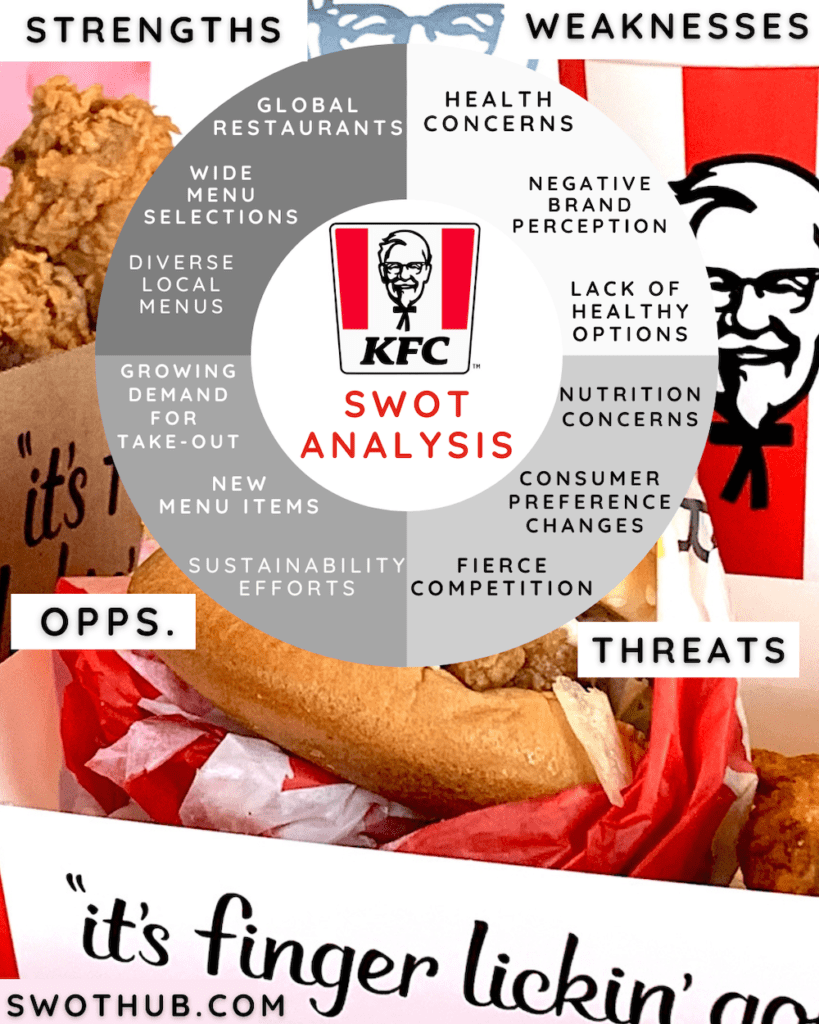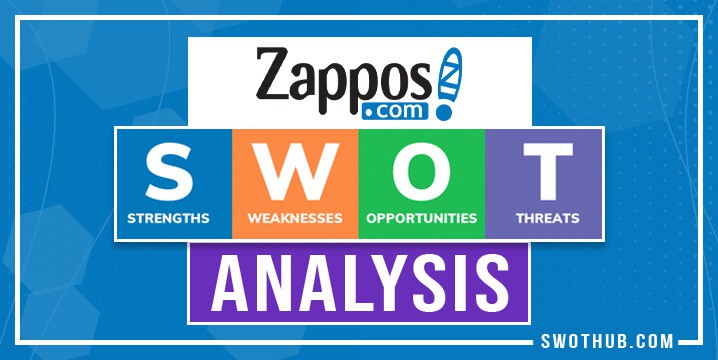Fried chicken has been a worldwide favorite in the restaurant industry for generations. In this Kentucky Fried Chicken, KFC SWOT analysis, we look at how the southern icon for fried chicken has transformed its business into a globally recognized brand. Look at how the parent company, Yum! Brands have used their strengths and opportunities against KFC’s competitors like Jollibee and Chick-fil-A. In this KFC SWOT analysis, we also look at its threats and weaknesses to see if this powerhouse of a fried chicken restaurant can keep its edge.
Watch the Kentucky Fried Chicken SWOT Analysis on SWOT Hub’s YouTube channel.
Table of Contents
KFC History of Kentucky Fried Chicken:
KFC (Kentucky Fried Chicken) was founded in 1930 by Harland Sanders, who initially operated a roadside restaurant in Corbin, Kentucky. He developed a secret recipe for fried chicken that became popular, and he eventually franchised the business.
In the 1950s, Sanders started to take KFC outside of Kentucky, and by the 1960s, the restaurant chain had spread across the country. Sanders sold the business to a group of investors in 1964, and the investors went public with it in 1966. KFC has encountered many difficulties over the years, such as shifting consumer preferences, heightened competition, and issues with the food’s potential health risks.
Despite these difficulties, KFC has several advantages over its rivals. Its reputation and brand recognition are two of its key advantages. KFC is one of the most well-known fast-food chains in the world and has been around for more than 90 years. Its well-known slogan “Finger Lickin’ Good” and iconic logo serve to draw in customers.
In a KFC SWOT analysis, KFC also has a wide range of menu items, including chicken sandwiches, wraps, salads, and sides. This allows the chain to appeal to a broad range of customers and to adapt to changing consumer tastes. Additionally, KFC has a strong global presence, with over 22,000 locations in more than 135 countries. This gives it a competitive advantage over smaller chains that are focused on a single region.
Finally, by adding healthier menu items like grilled chicken and salads, KFC has been able to adjust to changing consumer preferences and concerns. This has aided in attracting customers concerned about their health and addressing worries about the effects of fried foods.
KFC has a long and storied history, and it has several advantages over its competitors, including strong brand recognition, a wide range of menu items, a global presence, and a willingness to adapt to changing consumer preferences.
KFC SWOT Analysis At-A-Glance
| Company | KFC |
| Parent Company | Yum! Brands |
| Industry | Restaurant |
| Founder | Harland “Colonel” Sanders, Pete Harman |
| Year founded | 1952 |
| CEO | Sabir Sami |
| Headquarters | Louisville, Kentucky |
| Number of employees | 820,000 + (2022) |
| Revenue (FY 2022) | US $2.83 Billion (2022) |
…
What is KFC affiliated with?
Yum! Brands is a multinational restaurant company that owns and operates several well-known fast-food chains, including KFC, Taco Bell, and Pizza Hut.
Yum! Brands has a strong connection with KFC as it is the parent company of the chain. In 1997, Yum! Brands (then called Tricon Global Restaurants) acquired KFC and has owned it ever since. Yum! Brands has been instrumental in expanding KFC’s global presence, particularly in emerging markets.
KFC SWOT Analysis:
A SWOT analysis is a framework used to assess a company’s competitive situation and to create strategic planning. By taking KFC’s strengths and weaknesses, threats, and opportunities into account, we may better gain in-depth knowledge about KFC. In this article, we’ll be taking a look at KFC’s SWOT framework to better understand its competitive position and potential for future growth. See how KFC competitors fare against them and learn about KFC’s strengths, weaknesses, opportunities, and KFC threats.
KFC SWOT Analysis Strengths:
The areas where a company excels above average or in a manner that distinguishes it from its rivals are its strengths. KFC strengths are outlined in this KFC SWOT analysis. Some of its strengths compared to competitors include:
Global brand recognition: KFC is a well-known, well-recognized brand. This gives it an edge over newer rivals who might not enjoy the same level of brand recognition.
KFC has a presence in over 135 countries, and many of these countries have adapted the menu to cater to local tastes and preferences. In a KFC SWOT analysis, here are some examples of KFC’s international versions:
- China: In a KFC SWOT analysis, KFC is extremely popular in China and has over 5,000 restaurants in the country. The Chinese menu includes items such as Dragon Twister, Spicy Diced Chicken, and Egg Tarts.
- India: KFC in India has a range of vegetarian options, such as the Veg Zinger burger and Paneer Zinger burger. The chain also offers local favorites such as rice bowls, chicken curries, and masala fries.
- Japan: In Japan, KFC offers a “Christmas chicken” meal, which has become a popular tradition in the country. The meal typically includes fried chicken, cake, and champagne.
- South Africa: KFC in South Africa offers a variety of “streetwise” meals that are inspired by local street food. These meals include items such as the Streetwise Two, which includes two pieces of chicken and a small portion of fries.
- Mexico: KFC in Mexico offers a range of menu items that feature local flavors, such as the Salsa Twister, which includes chicken, salsa, and avocado.
What are some of the strengths of KFC?
Wide selection of menu items: KFC’s menu is diverse and includes chicken sandwiches, wraps, salads, sides, and desserts. It can thus appeal to a wide range of customers and change to reflect shifting consumer preferences.
Strong distribution network: KFC has a large and well-established distribution network, which enables it to efficiently deliver products to its restaurants and customers.
Global presence: KFC has a strong global presence, with over 22,000 locations in more than 135 countries. This gives it an advantage over smaller chains that are focused on a single region.
Innovation: KFC has been able to innovate and introduce new menu items, such as grilled chicken and plant-based options, to attract new customers and address changing consumer preferences.
KFC SWOT Analysis Weaknesses:
The weaknesses of a company are those that limit its potential, make it less competitive, and prevent it from achieving its goals. In this section of the KFC SWOT analysis, we’ll look at KFC’s weaknesses. A few of their weaknesses compared to competitors include:
Health concerns: KFC’s menu is frequently criticized for being unhealthy, high in calories, and high in sodium. This may turn away customers who are seeking healthier options and result in a drop in sales.
Dependence on a single product: KFC’s primary product is fried chicken, which accounts for the majority of its menu items. This dependence on a single product makes it vulnerable to changing consumer preferences or health trends.
What are KFC’s Weaknesses?
Limited menu options for vegetarians and vegans: KFC’s menu still primarily caters to meat eaters, despite recent additions of some vegetarian and vegan options. Comparing this to rivals who provide more extensive vegetarian and vegan options can be disadvantageous.
Negative brand perception: KFC has faced criticism in the past for issues such as animal welfare and environmental concerns. This negative brand perception can harm customer loyalty and make it difficult for the company to attract new customers.
Regional competition: In a KFC SWOT analysis, despite being a global brand, KFC faces fierce competition from local fast-food chains that may be more aware of regional tastes and preferences.

KFC SWOT Analysis Opportunities:
The following portion of this KFC SWOT analysis will examine some of KFC’s opportunities compared to competitors:
Growing demand for takeout and delivery: The COVID-19 pandemic has increased takeout and delivery demand, which presents KFC with an opportunity to broaden its online ordering and delivery services.
Expansion into new markets: KFC has already expanded into many emerging markets, but there are still many regions where it could potentially expand, such as Africa and the Middle East.
New product introductions: KFC has the chance to roll out new items that cater to shifting consumer tastes, like healthier options, plant-based substitutes, or ethnic cuisines.
Embracing technology: In a KFC SWOT analysis, they can leverage technology to enhance the customer experience, such as implementing mobile ordering, contactless payment options, and personalized marketing.
Increasing consumer interest in sustainability: KFC has the chance to enhance its environmental sustainability practices by cutting waste, choosing ethically sourced ingredients, and using more sustainable packaging.
KFC SWOT Analysis Threats:
Threats pose a risk to every company’s stability and profitability. In a SWOT analysis of KFC, some of its largest threats compared to competitors include:
Competition is fierce: KFC faces fierce competition from other fast-food chains, including McDonald’s, Burger King, and Subway, which could harm its market share and profitability. See later in the analysis about KFC’s competitors.
Health and nutrition concerns: Consumers are increasingly concerned about health and nutrition, which could negatively impact KFC’s sales and reputation if it does not respond with healthier menu options.
Consumer preference changes: If KFC does not modify its menu to accommodate these preferences, it may be in danger. One example is the rising demand for plant-based substitutes.
Economic uncertainty: In a KFC SWOT analysis, economic uncertainty, such as a recession or financial crisis, can impact consumer spending on fast food, which can negatively impact KFC’s sales and profitability.
Disruptions to the supply chain: Natural disasters, trade restrictions, and transportation problems can all have an adverse effect on KFC’s ability to source ingredients and distribute goods, which can have an adverse effect on its business operations and financial performance.
Who are KFC’s Biggest Competitors?
In a SWOT analysis of KFC, its competitors would fall under the “threats” category. Here are some of KFC’s main competitors in the industry.
- McDonald’s
- Burger King
- Wendy’s
- Subway
- Chick-fil-A
- Popeyes
All these businesses, which compete with KFC for market share and consumer attention, have substantial resources and marketing clout.
KFC SWOT Analysis: Recommendations and Conclusion:
KFC needs to focus on a number of key strategies to remain competitive in the fast-food restaurant industry.
To stay ahead of competitors, KFC could consider the following recommendations: :
- Increase menu options: KFC could increase its menu selections to better suit shifting consumer preferences by including healthier options, plant-based substitutes, or ethnic cuisines. This could aid KFC in setting itself apart from rivals and attracting a wider range of customers.
- Emphasize convenience: Convenience is a major factor in fast food purchasing decisions. KFC could emphasize its online ordering, delivery, and drive-thru services to make it more convenient for customers to order and receive their food.
- The customer experience could be improved: In a KFC SWOT analysis, KFC invested in technology, such as by implementing mobile ordering, contactless payment options, and personalized marketing. This might make KFC stand out from rivals and win over customers.
- Addressing issues with nutrition and health: KFC could address issues with nutrition and health by providing healthier menu options and more open disclosure of its nutritional information and ingredients. By doing this, KFC might win over health-conscious customers and establish a solid reputation.
- Innovate and stay ahead of trends: KFC could invest in research and development to stay ahead of trends and introduce innovative products that cater to changing consumer preferences. This could help KFC maintain a competitive edge and attract new customers.
Staying ahead of competitors will require KFC to continue to innovate, adapt to changing consumer preferences, and invest in enhancing the customer experience.
In this KFC SWOT analysis, we outline KFC’s advantages, disadvantages, opportunities, and threats in the fast-food sector. While KFC has many advantages over its rivals, including a strong distribution network and a well-known brand, it also has some disadvantages, including health concerns about its menu and a poor reputation as a brand.
FAQs for KFC SWOT Analysis
What company is KFC owned by?
KFC is owned by Yum! Brands, Inc., a multinational fast-food corporation.
How much is a KFC franchise?
The cost of a KFC franchise varies but typically ranges from $1.2 million to $2.5 million.
How do you qualify for a KFC franchise?
To qualify for a KFC franchise, you generally need a minimum net worth of $1.5 million and liquid assets of $750,000, along with experience in the restaurant industry. Specific requirements may vary by location.
This SWOT analysis also uncovered threats, including fierce competition, and shifting consumer preferences, as well as opportunities, including rising takeout and delivery demand and expansion into new markets. To stay competitive and ensure long-term sustainability in the fast-food industry, KFC must address these issues.





